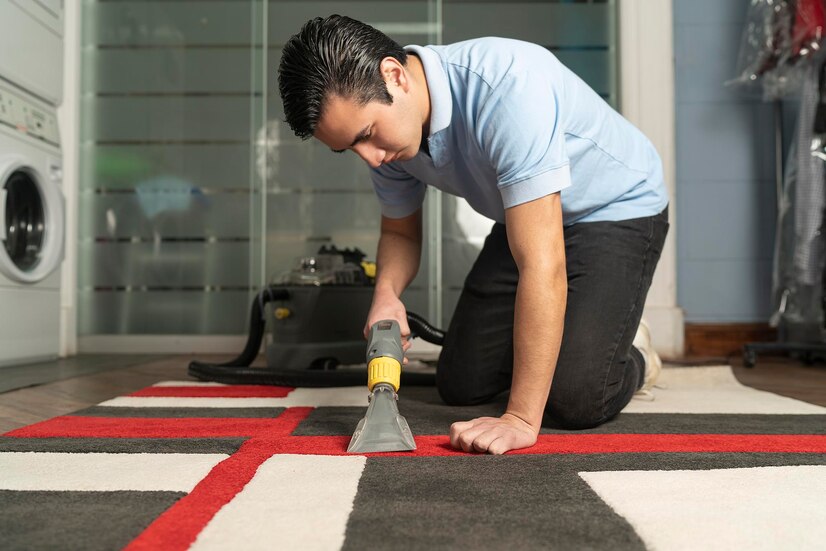If you work in a nice, cool, and modern office, you spend most of your day sitting at your desk and walking on a carpeted floor. Indeed, carpeted floors feel so much better to walk on; they are pretty to look at, absorb sound and reduce noise, help insulate the room, provide a non-slip and safer surface, and are just a lot more comfortable. However, there is also a good chance that the very carpet you love could be hiding some serious dangers.
As we all know, carpets are excellent dirt magnets. Foreign particles ranging from allergens, and bacteria to toxic chemicals could get trapped in between the fibres of the carpet; these things can pose potential health hazards. This is what commercial cleaning, particularly office cleaning and carpet deep cleaning, is about.
Allergens
One of the most common, and probably the biggest, danger hiding in between the fibres of your office carpets are allergens.
Allergens come in various forms, from dirt, dust, pet dander, dust mites, pollen, etc., which are all practically invisible to the naked eye. These particles get trapped on the carpet but can become airborne when someone walks on the carpet. People with hypersensitivity to these allergens can easily feel allergic reactions from these particles, such as sneezing, coughing, stuffy or runny nose, red, watery and itchy eyes, headaches, etc. Those with asthma, allergic rhinitis, or similar respiratory conditions will feel the worst of the symptoms.
If you often suffer from allergies, you may notice that your symptoms are usually worse t work. And if you work in a carpeted environment, there is a good chance it is caused by dirty office carpet.
To reduce your exposure to harmful allergens, make sure to invest in a vacuum cleaner that comes with a HEPA filter. HEPA is a special type of filter that traps extremely small particles. The good thing about hiring good commercial cleaning companies is that they use HEPA vacuums for their office cleaning.
Bacteria
Another common danger that could be lurking in your office caret is bacteria.
As said earlier, carpets are practically dirt traps. It traps anything and everything, including moisture. Beverage spills, wet food, or various liquids dropped on the carpet turn the carpet into a breeding ground for bacteria.
Bacteria, as we all know, can cause a long list of serious illnesses, such as pneumonia, meningitis, etc. To reduce your risk of these health problems, it is important to have your office carpet professionally cleaned.
Commercial office cleaners use HEPA filter vacuums, special cleaning equipment and commercial-grade cleaning agents to effectively clean and disinfect carpets. They can safely clean bacteria lurking between the fibres and deep into the carpet without damaging the fabric.
Toxic Chemicals
Another danger that is often overlooked in the office setting is toxic chemicals.
Often, office chemicals are treated with special chemicals to make them flame-retardant and stain-resistant. You will often see this in carpets placed in high-traffic areas, as they are incredibly convenient in terms of care and safety. However, over time, as the carpet ages, these special chemicals can off-gas, releasing toxic fumes into the air.
Some of the most common chemicals used in treating carpets are benzene, formaldehyde, and toluene. These chemicals have been linked to a variety of health problems, such as respiratory issues, dizziness, and headaches.
To reduce your chances of exposure to these chemicals, make sure to choose office carpets that are certified as low-emitting or free from harmful chemicals. If your office has already installed carpets with these chemical treatments, consider testing them for chemical emissions.
Mould
Mould is another common danger that is often overlooked in work settings like offices. Since carpets can trap moisture, they become damp. Hence, they become an ideal environment for mould growth. Mould can release spores into the air, and like allergens, they can cause respiratory and health problems.
To reduce your risk of exposure to mould, it is crucial to have your pipes checked for possible leaks, improve office ventilation, and use a dehumidifier to reduce humidity levels. Also, make sure to have your carpets cleaned by professional commercial cleaners.
Tips For Keeping Your Office’s Carpet Clean And Safe
Now that you know the dangers that could be lurking in your office carpet, it is important to take the necessary steps to keep your carpets clean and safe. Here are some tips for that:
Vacuum Regularly
Office carpets must be thoroughly vacuumed at least once a week to remove dust, dirt, and another allergen buildup.
Use HEPA Filter
Make sure to invest in a HEPA filter to effectively remove all small particles that have settled deep into the carpet.
Clean Up Spills As Soon As Possible
Prevent moisture from seeping deep into the carpet fibres by cleaning up spills promptly.
Invest In Safe Cleaning Products
Not all cleaning products are the same. Many may be effective in cleaning and killing bacteria, but they can be made from harmful chemicals. People hypersensitive to these strong cleaning solutions may be at risk of experiencing health problems such as allergic reactions and respiratory symptoms.
Have Your Office Carpets Professionally Cleaned
You can save yourself from all the hassles of cleaning and buying special cleaning equipment and cleaning solutions or hiring and training office cleaners by simply getting the services of professional office cleaners.
Professional commercial cleaning services include deep cleaning, which is exactly what office carpets need. Health experts recommend that office carpets must be deep cleaned at least once a year (twice for offices with heavy foot traffic) to remove deep-seater allergens and dirt and keep them clean and safe for everyone.
Takeaway
Your office’s carpet may seem innocuous, but it could be hiding some serious dangers. Save yourself from the stress of guesswork and hire professional commercial cleaning services to take care of your carpet cleaning needs.
Commercial cleaning services provide customized cleaning plans to give you the exact, comprehensive, and quality service you need. Also, these office cleaning services companies hire professional cleaners, train them, and equip them with advanced cleaning techniques and equipment to ensure safe and thorough cleaning of your office. Their experienced cleaners are fully trained and well-versed in handling various cleaning and building maintenance tasks, including deep cleaning.
Lastly, hiring professional cleaning services from legit professional commercial cleaning companies can help you save precious time and money in the long run. Not only that they have the manpower and special equipment to provide the highest quality cleaning, but they are also extremely efficient. They can work around your schedule, reduce downtime, and improve the productivity of your workplace.
Read Also:






















